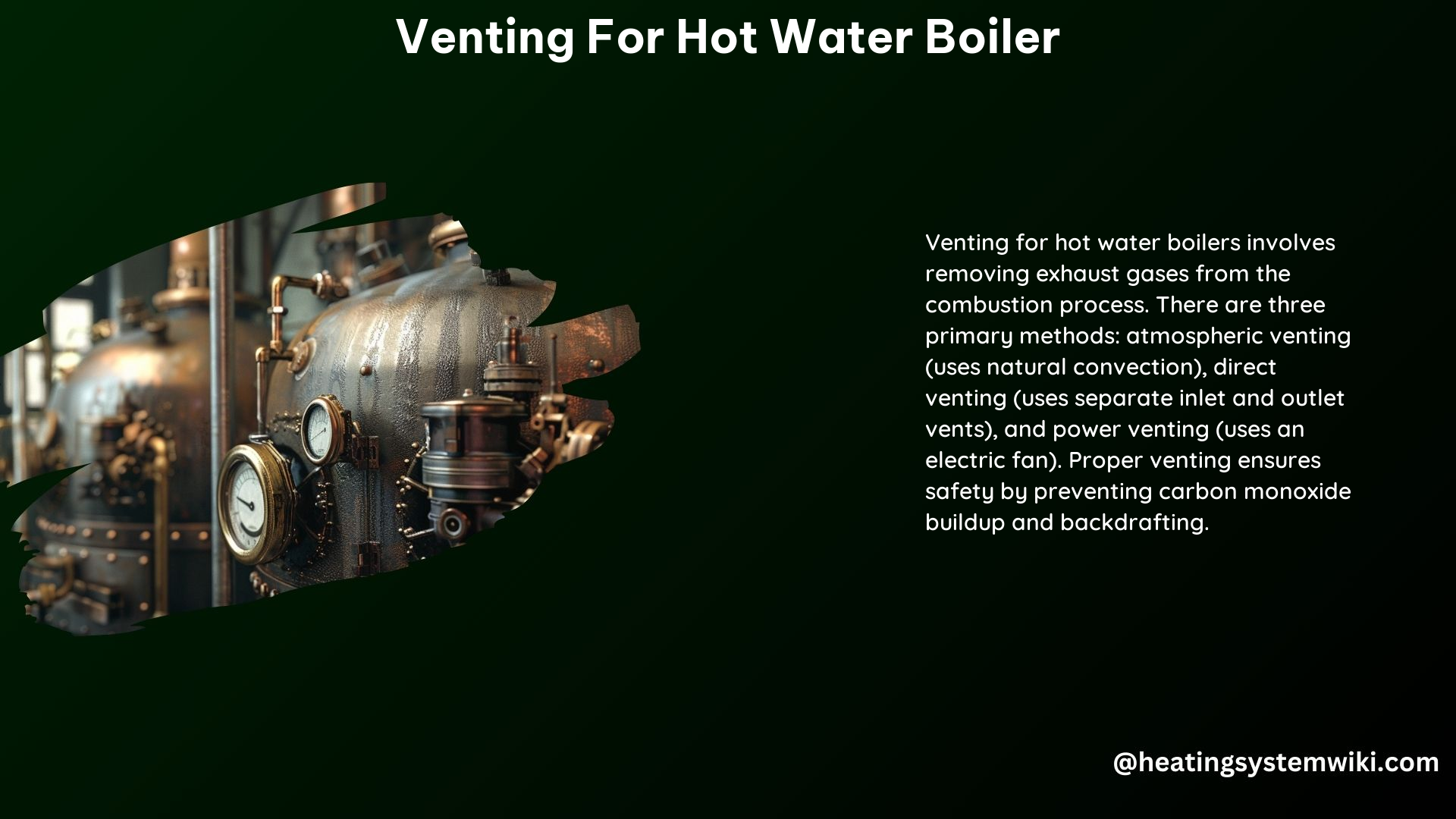Venting for hot water boilers is a critical aspect of ensuring safe and efficient operation. Proper venting is essential to remove harmful exhaust gases, prevent backdrafting, and maintain the optimal performance of the boiler system. In this comprehensive guide, we will explore the different venting options, technical specifications, safety risks, and mitigation strategies for hot water boilers.
Venting Options for Gas Water Heaters
1. Atmospheric Venting
- This is the most common method for venting hot water boilers, where a vertical or upward-sloping vent duct carries exhaust gases away from the boiler and out of the property via the roof or chimney.
- Atmospheric venting relies on natural convection, where hot gases rise and create a draw that promotes upward airflow.
- The minimum vent pipe diameter for atmospheric venting is typically 3 inches, but it can vary depending on the boiler’s BTU rating and the vent pipe length.
- Atmospheric venting systems must be designed to maintain a minimum vertical rise of 12 inches per foot of horizontal run to ensure proper draft and prevent condensation buildup.
2. Direct Venting
- Direct venting uses separate inlet and outlet vents to create a flow, with one vent pipe bringing air from the outside to the boiler and another carrying exhaust gases away from the boiler to the outside.
- This method is suitable for situations with insufficient ventilation within the installation space and minimizes backdrafting risks.
- Direct venting systems typically use 2-inch or 3-inch diameter PVC or polypropylene pipes for both the air intake and exhaust.
- The maximum length of the vent pipes for direct venting is determined by the boiler manufacturer’s specifications, often ranging from 40 to 100 feet, depending on the number of elbows and the total equivalent length of the vent system.
3. Power Venting
- Power venting uses an electric blower fan to assist the flow of exhaust gases, allowing for horizontal or vertical vent ducts.
- This type of venting is more efficient and can utilize PVC piping, which is less expensive and easier to assemble than metal piping.
- Power venting systems require a nearby electrical outlet to power the blower fan, which typically operates at 120 or 240 volts.
- The minimum vent pipe diameter for power venting is usually 2 or 3 inches, depending on the boiler’s BTU rating and the vent pipe length.
- Power venting systems can be designed with longer vent runs and more elbows compared to atmospheric venting, as the blower fan provides the necessary draft.
Technical Specifications

Minimum Vent Pipe Slope
- A minimum slope of 1/4 inch per linear foot is recommended for all vent pipes to ensure proper drainage of condensate and prevent low spots in the vent system.
Vent Pipe Materials
- Vent pipes can be made of metal (such as galvanized steel, stainless steel, or aluminum) or PVC, depending on the type of venting system.
- Metal vent pipes are typically used for atmospheric venting, while PVC or polypropylene pipes are common for direct and power venting systems.
- The choice of vent pipe material should be based on the boiler manufacturer’s recommendations and local building codes.
Electrical Requirements
- Power venting systems require a nearby electrical outlet to power the blower fan, which typically operates at 120 or 240 volts.
- The electrical circuit for the power venting system should be properly sized and grounded to ensure safe and reliable operation.
Safety Risks and Consequences of Improper Venting
Carbon Monoxide Poisoning
- Improper venting can lead to the buildup of carbon monoxide, a highly poisonous gas, inside the home, posing a severe health hazard to occupants.
- Carbon monoxide is an odorless, colorless gas that can cause nausea, dizziness, and even death if exposure levels are high enough.
Backdrafting
- Poor vent design or installation can cause exhaust gases to fail to exit the home, leading to backdrafting and potential health hazards.
- Backdrafting occurs when the vent system is unable to create a sufficient draft, causing exhaust gases to be drawn back into the living space instead of being expelled outside.
Water Heater Damage
- Improper venting can cause the water heater to backfire or overheat, leading to damage and potentially voiding the warranty.
- Backfiring can occur when the vent system is unable to effectively remove exhaust gases, leading to a buildup of pressure and potential explosions.
Inefficient Operation
- Improper venting can reduce the efficiency of the water heater, leading to higher energy bills and reduced performance.
- Restricted airflow or improper draft can prevent the boiler from operating at its optimal efficiency, resulting in increased fuel consumption and higher operating costs.
Mitigating Safety Risks
Proper Installation
- Ensure that the venting system is installed correctly, following the manufacturer’s instructions and local building codes.
- Hire a licensed and experienced HVAC technician to install the venting system to ensure it meets all safety and performance requirements.
Regular Maintenance
- Regularly inspect and maintain the venting system to prevent blockages and ensure proper function.
- Clean the vent pipes, check for any cracks or damage, and ensure that the vent termination is clear of obstructions.
Carbon Monoxide Detectors
- Install carbon monoxide detectors in the home to alert occupants of potential CO buildup, which can indicate a problem with the venting system.
- CO detectors should be placed near sleeping areas and in other high-traffic zones within the home.
By understanding the different venting options, technical specifications, and safety risks, homeowners and HVAC professionals can ensure that hot water boilers are properly vented, operating safely, and maintaining optimal efficiency. Following manufacturer guidelines and local building codes is crucial for the safe and reliable operation of hot water boiler systems.
